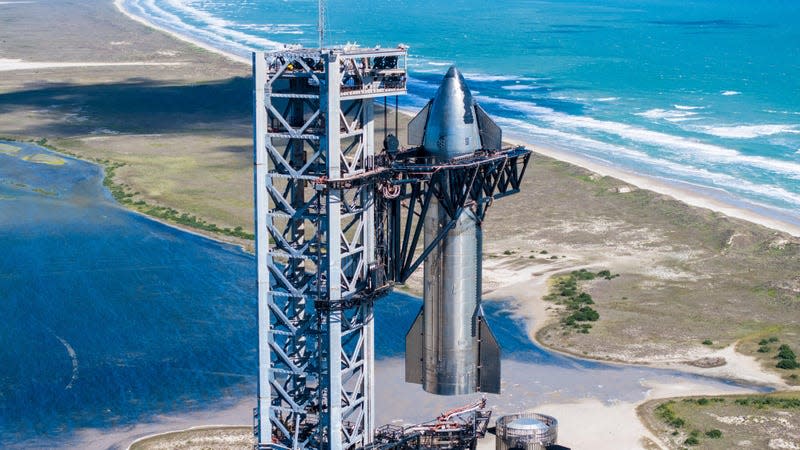SpaceX's Starship Rocket Could Fly Again in the Coming Weeks

SpaceX’s Starship rocket at the company’s launch facility in Boca Chica, Texas.
SpaceX is preparing to launch its Starship rocket for the second time, aiming for mid-November for another flight test of its launch vehicle after the first one didn’t go so well.
It’s been over six months since Starship lifted off for the very first time, a problematic debut that has kept the rocket grounded since then. But now SpaceX claims that the second test flight of its megarocket could launch as early as mid-November, “pending regulatory approval,” the company wrote on X. Sources also told Spaceflight Now that Starship’s launch could take place as early as November 13.
Read more
Even In Matte Black, The Tesla Cybertruck Still Looks Like Crap
Attack On Titan Anime Finale Rewrites The Ending For The Better
Fossil Fuel-Funded Think Tank Claims Electricity Costs $17 Per Gallon
Starship embarked on its initial flight on April 20, but after entering into a catastrophic tumble about four minutes into the mission, ground controllers were forced to issue a self-destruct command. The rocket, troublingly, did not respond to the command right away, leading to a dangerous delay over the Gulf of Mexico. At the Boca Chica launch site in south Texas, the big blast off resulted in several serious issues, including major damage to the launch mount, the igniting of several wildfires, disruption to local wildlife, and the widespread scattering of debris across hundreds of acres.
The FAA closed its investigation into Starship’s botched flight in September, handing SpaceX a list of 63 corrective measures to secure its next Starship launch license. The measures included a redesign of the vehicle’s hardware to prevent leaks and fires, and a modification of the launch pad to boost its resilience. SpaceX has made some changes to the launch pad since Starship’s first launch, including steel reinforcements beneath the launch mount and a new water deluge system to quell the power of Starship’s 33 Raptor engines.
“Starship’s first flight test provided numerous lessons learned that directly contributed to several upgrades to both the vehicle and ground infrastructure to improve the probability of success on future flights,” SpaceX wrote on its website. “The second flight test will debut a hot-stage separation system and a new electronic Thrust Vector Control (TVC) system for Super Heavy Raptor engines, in addition to reinforcements to the pad foundation and a water-cooled steel flame deflector, among many other enhancements.”
There is a lot riding on Starship’s ability to ace its test flight this time around. SpaceX is under a $2.89 billion contract to use a lunar lander version of its Starship rocket in landing humans on the Moon by late 2025 as part of the space agency’s Artemis 3 mission, and then again for Artemis 4 in 2028, under a separate $1.15 billion contract signed last year. SpaceX also needs its megarocket to carry the upgraded version of its Starlink satellites to orbit, helping the company meet growing demand for its internet service.
Want to know more about Elon Musk’s space venture? Check out our full coverage of SpaceX’s Starship megarocket and the SpaceX Starlink internet satellite megaconstellation. And for more spaceflight in your life, follow us on X and bookmark Gizmodo’s dedicated Spaceflight page.
More from Gizmodo
Sign up for Gizmodo's Newsletter. For the latest news, Facebook, Twitter and Instagram.

